Global warming is the perpetual increase in the temperature of the earth’s surface. Emission of greenhouse gases is said to be the major cause of this change in temperature (Houghton J 2004, p.45). While some of the effects of global warming are currently observable, other effects are projected to occur in future.
Physical destruction of vegetation is also considered to be a contributor to global warming. Vegetation is the biggest consumer of the green house gas, carbon dioxide (Houghton J 2004, p.47). There is consensus among majority environmental scientists that the effect of global warming could be destructive to all forms of life on earth. However, some scientists claim that global warming is a cyclic phenomenon.
This means that the world undergoes constant cycles of warming and cooling (Singer & Avery 2007, p.51). According to these researchers, the earth’s temperature is bound to drop suddenly after reaching a certain maximum. According to the scientists, the world will get super cooled and return to ice age from where warming will start all over again (Singer & Avery 2007, p.55).
Currently, there are several effects of global warming that are observable on the earth’s surface. One of the effects is the rise of the seal level due to the melting of the ice at the poles. This reduces the terrestrial landmass available for settlement. Another effect is desertification. This is caused by inconsistent weather patterns and rise in temperature. Several authors have outlined more effects of global warming. However, majority of researchers seem to agree that global warming is a threat to human existence.
Study by UNFCCC
For scientist to assess the impact of global warming on the environment, constant observation of natural events is necessary. UNFCCC committed itself to studying weather patterns for a long time in order to establish the truth about climate change. This international organisation relies on data from countries to assess the world’s climate (United Nations Framework Convention on Climate Change 2006, p.25).
Countries that are members of this organisation were required to provide data on weather and climate patterns. In addition, the implications of climate change were assessed and submitted to the organisation. This data was used to assess the situation concerning the state of the climate and the effects of the change, especially global warming. Global warming is the major consideration, since the consensus among scientist is that it is the main cause of environmental instability.
Africa
The effects of climate change in the world were reported as per continent. Africa, which lies across the equator, was reported to have one of the most unstable climates in the world. Climate changes due to global warming caused alternating extreme weather patterns.
Floods and droughts occurred in succession leading to famine and conflicts as people fought for the scarce food. Waterborne diseases increased mortality due to the frequent flooding. This flooding is believed to be a result of the rising sea level (United Nations Framework Convention on Climate Change 2006, p.28).
In turn, the rising sea level is a result of the perpetual rise in temperature at the poles. Extreme weather leads to outbreak of diseases favoured by the particular weather conditions of every region. Furthermore, the continent, which is a habitat for many animal and plant species, is becoming increasingly uninhabitable due to the extreme weather conditions and reduction of vegetation by droughts and excess rain.
Asia
Asia, the largest continent, is reported to experience an increase in occurrence of natural calamities. Although the continent has experienced calamites throughout the history, a notable increase in frequency of the calamities due to global warming has been registered in the recent years. High fluctuations of temperatures have increased the frequency of extreme weather with floods, landslides, and destructive storms being the most prevalent.
Due to the complex climate pattern of the continent, global warming has occasionally triggered heat waves on the continent. The extreme temperature, coupled with a wet climate, lead to outbreak of diseases such as cholera, which are favoured by such conditions. Asia is considered to be one of the most volatile regions for its numerous disasters (United Nations Framework Convention on Climate Change 2006, p.27). Increase in the number of disasters per year in the continent has reduced chances of individual survival for people who live on it.
Latin America
Latin America was also associated with natural disasters by the findings of UNFCCC. Storms such as hurricanes and cyclones are a common occurrence in the continent. The frequency of such storms has been on the rise, and is continuously causing damage to the coral reefs at the coast (United Nations Framework Convention on Climate Change 2006, p.29).
In addition, storms cause considerable loss of property and human life. Scientists agree that the increasingly violent nature of winds is a result of global warming and the change of climate patterns in other areas of the world. Data indicated that the diverse life forms in the continent have been affected by the inconsistent weather patterns and disastrous storms.
North America and Europe
In North America, global warming was found to be the cause of numerous natural disasters such as tornadoes, hurricanes and gales. These winds were becoming more frequent and more violent as average surface temperature increased. The winds are often the cause of loss of lives and destruction of property in the continent, particularly in the southern states of the United States (United Nations Framework Convention on Climate Change 2006, p.32).
On the other hand, Europe usually experiences occasional heat waves. These heat waves often cause the deaths of patients with terminal diseases. The frequency of such heat waves and their intensity indicated that global warming had a role to play. Data collected before the year 2006 indicated that temperatures recorded in the last fifteen years in Europe had some figures that were the highest in modern history. This indicated a deteriorating climate in Europe (United Nations Framework Convention on Climate Change 2006, p.45).
National Academy of Sciences
Another study by the United States National Academy of Sciences covered the last five hundred years. It is during this period that the rate of global warming started escalating due to the industrialisation of nations (Wang & Chameides 2006, p.21). In 2003, a comparison of annual temperatures of the year and those of all years in modern history indicated that the last decade of the twentieth century was hottest in the millennium.
This was particularly so for countries in Europe such as the United Kingdom which at one point recorded a temperature of 100.6 Fahrenheit (Wang & Chameides 2006, p.24). The increase in temperature coincided with the increase in mortality in European countries. This change of the rate of mortality was remarkably associated with people afflicted by respiratory diseases (Wang & Chameides 2006, p.23).
The study was continued from 2003, and the effects of global warming were noted. Every year, each consecutive years was hotter than the previous one, validating the claims that the world was getting progressively hotter. This study also noted the increase in frequency of persistent and intense rain usually known as El Niño (Wang & Chameides 2006, p.36). The persistent rains are directly attributable to global warming and the rise of the sea level. These rains were destructive leading to shortage of food around the world.
University of California
The University of California also undertook a study to establish the extent of damage to biodiversity by global warming (Botkin et al. 2007, p.5). Researcher found that many species face extinction due to global warming. A comparison with the last ice age showed that a few species became extinct in that period compared to modern times (Botkin et al. 2007, p.16). Only a few species can survive in the face of a constantly changing climate and unpredictable extreme weather conditions.
Government of Japan
The government of Japan also conducted a study on the effect of global warming on production. The study focused on the effect of the rising temperature on the productivity of fish, chicken and crops (Ministry of Agriculture, Forestry and Fisheries-Japan 2007, p.4). The study revealed that the Japanese islands in the south of the Japan were becoming unsuitable for growth of tomatoes.
This was attributed to the perpetual rise in temperature. Chicken did not lay many eggs during the heat waves and hot months (Ministry of Agriculture, Forestry and Fisheries-Japan 2007, p.10). In addition, it was noted that some species of fish were migrating from the sea around Japan since it was getting warmer each year.
Discussion
From the reports of various studies, it can be concluded that global warming is not only a threat to some species on earth, but also to the human race. Since we depend on other species for survival, their extinction can also cause the extinction of humankind. Moreover, the high temperatures in some regions of the earth are already unbearable to average humans.
Global warming is also related to political instability, particularly in Africa. Political instability is very destructive, and is a potential threat to human existence. It is evident that if global warming continues, people may not coexist with one another in future.
Destruction of natural resources by global warming is likely to cause competition for the scarce remainder in the struggle for survival. Natural calamities are also a common occurrence around the world. Majority of the calamities are a result of climate change. Continued escalation of earth’s surface temperature evidently leads to increase in frequency of occurrence of natural disasters.
Conclusion
The only solution to global warming is to shift the use of energy from fossil fuel to other non-pollutant alternatives. Fossil fuel is the cause of the presence of excess greenhouse gases in the atmosphere (Maslin 2002, p.62). Although life on earth needs a certain degree of greenhouse effect to survive, it is imperative that a shift to another type of fuel be implemented. There are several alternatives to fossil fuel. Nuclear power is an attractive option.
This source can provide an inexhaustible source of energy. However, this alternative has grave health and security implications (Maslin 2002, p.59). The sun is the safest source of energy. Energy from the sun can be used to generate electricity to replace the fossil fuel. The technology used to trap energy from the sun is expensive (Maslin 2002, p.63). However, energy from the sun presents the most attractive alternative. There are other sources of energy such as tidal currents in the sea.
Although generation of electricity from such currents is already in practice, it is expensive for wide scale adoption around the world. With appropriate management, a combination of alternative sources of energy can be used to substitute fossil fuel in order to stop global warming.
References
Botkin, D, Saxe, H, & Araùjo, M 2007, ‘Forecasting the Effects of Global Warming on Biodiversity’. Bio Science, vol. 53, no. 3, pp. 226-236.
Houghton, J 2004, Global Warming: The Complete Briefing, Cambridge University Press, Cambridge.
Maslin, M 2002, Global warming: causes, effects, and the future, Voyageur Press, Stillwater, MN.
Ministry of Agriculture, Forestry and Fisheries 2007, ‘Impact of Global Warming on Agriculture, Forestry and Fisheries and Possible Countermeasures in Japan’. Report on Research and Development in Agriculture, Forestry and Fisheries, no. 23, pp. 2-19. Web.
Singer, S F & Avery, D T 2007, Unstoppable global warming: every 1,500 years, Rowman & Littlefield Publishers, Lanham, Md.
United Nations Framework Convention on Climate Change 2006, ‘Climate change: Impacts vulnerabilities, and adaptation in developing countries’. United Nations Framework Convention on Climate Change, vol. 4, no. 6, pp. 1-68.
Wang, J., & Chameides, B 2006, ‘Global Warming’s Increasingly Visible Impacts’. Environmental Defense, vol. 1, no. 4, pp. 1-63.


